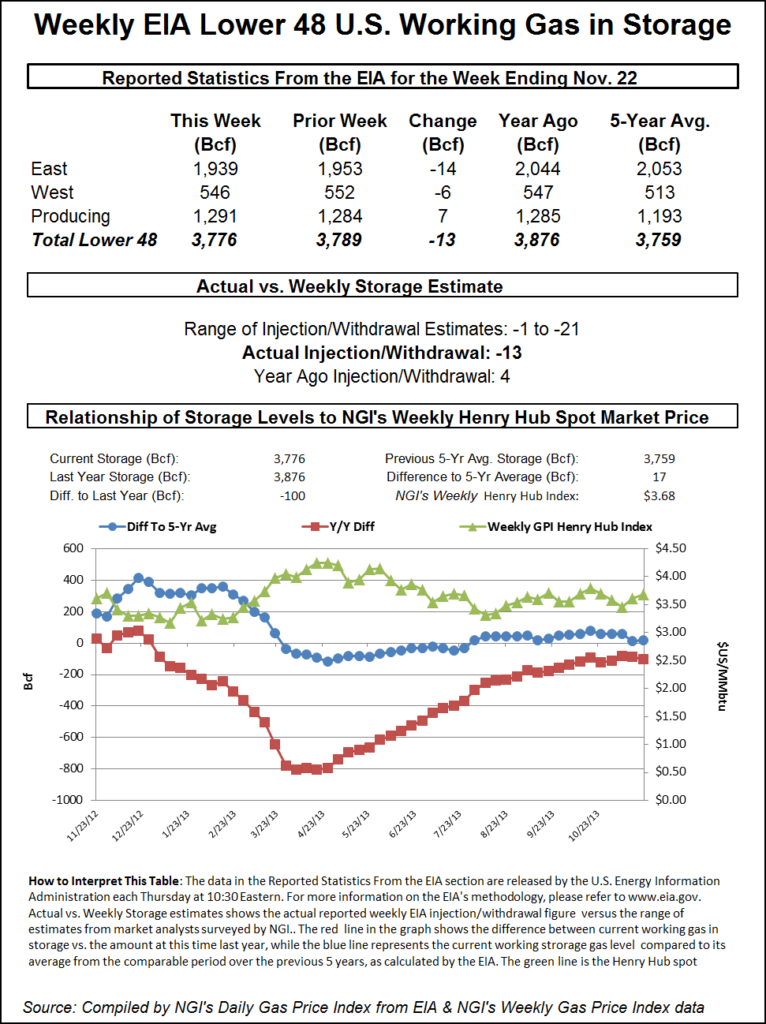Markets | NGI All News Access | NGI Data
Physical, Futures Chart Different Courses; January Adds 3 Cents
Physical natural gas for Sunday and Monday delivery tumbled nearly 20 cents in Wednesday’s trading, yet if Boston, New York and Philadelphia are excluded from the analysis, the decline comes in at a more moderate 11 cents.

Traders had to look beyond the Thanksgiving Holiday to the Sunday-Monday period and that uncertainty, plus full storage and temperatures expected to be close to seasonal averages, ended up being enough to restrain buyers. New England posted losses at or above $3 and the Mid-Atlantic was down solid double digits. Declines in the Midwest were more tempered and ranged anywhere from a few pennies to a dime or more.
The Energy Information Administration in its noon release of storage data reported a withdrawal of 13 Bcf, about what traders were expecting, but prices advanced nonetheless. At the close of trading January had risen 3.1 cents to $3.895 and February was higher by 2.9 cents to $3.899. January crude oil skidded $1.38 to $92.30/bbl.
The storage report came as something of a surprise. “I don’t know why the market rallied off the number. It was -13 and the market was looking for -12,” said a New York floor trader. “A difference of 1 Bcf makes the market move?” he queried. “It wasn’t really a bullish number.”
Tim Evans of Citi Futures Perspective viewed the report as “constructive” and “a larger draw than it might have been and no offset to the larger net withdrawals anticipated for the weeks ahead as colder temperatures boost heating demand.”
While coming in smaller than the five-year average withdrawal of 15 Bcf, the actual 13 Bcf decline was much larger than last year’s date-adjusted 2 Bcf withdrawal.
Inventories now stand at 3,776 Bcf and are 100 Bcf less than last year and 17 Bcf above the five-year average. In the East Region 14 Bcf was withdrawn and in the West Region 6 Bcf was pulled. Inventories in the Producing Region rose by 7 Bcf.
Quotes at Northeast locations had the trajectory of a safe falling from a 10 story building as temperatures were forecast to reach close to normal levels. Forecaster Wunderground.com predicted Wednesday’s high of 58 degrees in Boston by Sunday would drop to 43 and Monday 42. The seasonal high in Boston is 48. New York City’s Wednesday high of 48 was forecast to ease to 47 Sunday and 46 Monday. The normal late-November high in New York is 50. Philadelphia’s high reading of 42 was expected to reach 46 on Sunday and 47 Monday. The normal high in Philadelphia is 49.
The National Weather Service in suburban Philadelphia predicted that “an area of low pressure located over southern New England [Wednesday] will move northeast. The low will move into Canada tonight. High pressure will build into the area tomorrow and Friday before sliding north and then east of the region over the weekend. Another area of low pressure is forecast to [reach] the area early next week.”
New England power requirements were expected to fall then rise by the start of December. New England ISO forecast that Wednesday’s peak load of 17,450 MW would fall to 16,990 MW by Sunday and jump to 18,140 MW Monday.
Traders moving gas into the Chicago area reported normal operations following a recent series of storms earlier in the week. “I didn’t have any trouble with my gas,” said a Houston-based trader. “With it being 32 degrees in Texas there could be freeze-offs, but I haven’t heard of anything. In the Chicago area they are used to that sort of thing, but there could be load loss from damaged power lines. That doesn’t appear to be material,” he said.
Futures traders see the market stretched at $4. “As long as this dynamic of y over y deficit contraction continues, a significant or sustainable price selloff could prove elusive,” said Jim Ritterbusch of Ritterbusch and Associates. “Nonetheless, we see the market beginning to approach the red zone on the upside as we are having difficulty constructing a sustainable $4 pricing environment within the newly prompt January contract.”
Traders had an early release of storage data to chew on as a result of the Thanksgiving Holiday. Floor trading will be closed Thursday, but little action is expected during Friday’s session. Expectations were for a small draw in the 12 p.m. EST release of Energy Information Administration storage figures. Last year, 2 Bcf was withdrawn, and the five-year average comes in at a 15 Bcf pull. IAF Advisors in Houston was looking for a 9 Bcf decline, and a Reuters survey of 17 traders and analysts revealed a 10 Bcf average with a range of minus 1 to minus 21 Bcf.
© 2024 Natural Gas Intelligence. All rights reserved.
ISSN © 1532-1231 | ISSN © 2577-9877 |
